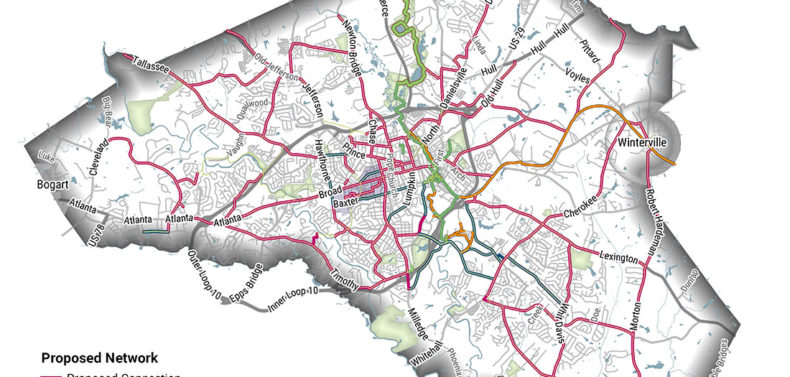The local advocacy group BikeAthens published its last map of bike routes in 2010 and hasn’t updated it since.
While there are several reasons why—the rise of smartphones, for one—there also simply wasn’t much to update. “We weren’t really worried about the map being out of date, because not much changed,” says Jason Perry, president of BikeAthens’ board of directors.
But since 2018, Athens has seen a number of new bike projects take shape, like bike lanes on College Station Road—a major commuter route from the Eastside to campus—and the city’s first separated bike lanes on Hancock Avenue downtown. Work on another phase of the North Oconee River Greenway will start soon near Oconee Hill Cemetery, which will also connect the Eastside to campus, downtown and points north. Athens-Clarke County is also making progress on the Firefly Trail between downtown and Winterville, with a replacement for the crumbling “Murmur” trestle in the works.
“We’re seeing this explosion in bike and pedestrian infrastructure, at least in certain corridors,” Perry says.
And more is on the way over the next few years. The Athens in Motion plan, overseen by a citizen committee and accepted by the Athens-Clarke County Commission (though not approved, which would tie the commission to the plan’s recommendations) includes dozens of bike and pedestrian projects. The renewed emphasis on alternative transportation also coincides with a global biking boom during the COVID-19 pandemic.
The first batch of four projects are now in the early design stages. Those projects will bring multi-use paths to Cherokee Road, Jefferson River Road and Riverbend Road, and a sidewalk and two-way bike path to Barber Street.
Whereas most of Athens’ existing bike lanes, like those on Lumpkin and Baxter streets, are merely painted stripes, multi-use paths provide a shared space for walkers, joggers, cyclists and people on other non-motorized vehicles that’s safer because it’s separated from cars in the roadway. The approach on Barber is a bit different because it’s expected to be busier, so planners decided to separate the cyclists from people on foot, too.
“We wanted to protect the pedestrians as well as the cyclists, so the cyclists will have their own basically two-lane road,” says Daniel Sizemore, the ACC Transportation and Public Works Department’s bike and pedestrian coordinator. “The more we can reduce conflict points, the better.”
Of the four projects, the one on Barber Street is the most complex because it’s an urban environment, with limited right-of-way. Currently, the plan calls for converting the four-lane section of Barber south of Newton Bridge Road to three lanes to create space and save money. Around Boulevard, cyclists will have to share the road with cars, but a “speed table” or raised intersection, curb bump-outs and sharrows should slow down traffic. A multi-use path “would really eat up a lot of front yard there,” Sizemore says.
Athens in Motion includes about 20 years’ worth of projects on major roads all over the county. Consultant Toole Design Group scored the projects based on factors like equity (historically underserved neighborhoods), connectivity (filling in gaps; access to jobs and services), traffic speed and level of comfort for users. Eventually, it will be easier and safer to walk or bike from any part of the county to another.
“It takes a lot to complete a network, and until you complete that network, you’ll never see that heavy usage,” Sizemore says. “Ultimately, we’re looking at that long-range connectivity.”
The painted-lane approach is cheap, but it has its limitations. In a survey conducted for Athens in Motion, 51% of respondents said they were interested in biking but didn’t feel safe doing it. Those cautious or concerned individuals may not ride at all, or they may pedal on the sidewalk, which is generally illegal for adults in Georgia.
The plan also emphasizes equity, and for Perry, that is the most important goal. Some projects can serve both needs. For example, a bike route on Barber Street could entice more people in the affluent Boulevard neighborhood to ride, but it will also make biking to work less dangerous for industrial employees in the Chase Street area who are doing it already.
“There are lots of different routes people ride regardless of whether you or I would consider it comfortable,” Perry says. “They have no choice, they’ve got to get where they’re going, and the bike is their only option.”
All of this comes at a cost, though. ACC’s first forays into bike infrastructure were mostly done on the cheap—restriping roads when they were due to be repaved and repainted anyway. Multi-use paths carry price tags in the millions. A local transportation sales tax (T-SPLOST) voters approved in 2017 includes $11 million for sidewalks and $6 million for bike projects, as well as other pots of money for Prince Avenue, West Broad Street, Atlanta Highway and Lexington Road that could be used for those purposes. Six recently approved tax allocation districts around the county that funnel revenue from new growth into infrastructure are another potential source of funding, Sizemore says.
The public comment period for Barber Street starts Apr. 28, and plans are available at accgov.com/barber. “We want to hear from the public, see what they think and let that inform our decision,” Sizemore says.
Meanwhile, Perry says BikeAthens is working with UGA to create a new, digital version of its bike-route map. “What that map continues to highlight,” he says, “is the glaring lack of connectivity from certain areas to others.
Like what you just read? Support Flagpole by making a donation today. Every dollar you give helps fund our ongoing mission to provide Athens with quality, independent journalism.










